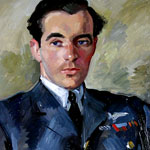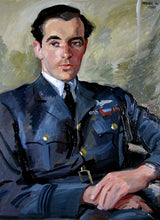Squadron Leader Hugh Scott, R.A.F.V.R., D.F.C., Croix de Guerre
Adding product to your cart
Measurements: Overall: 84cm (33in) x 64cm (25in)
Three quarter length oil on board portrait, signed and dated ‘Parker ’46 / Oslo’. In period glazed frame.
Distinguished Flying Cross (London Gazette 12.6.1945)
Recommendation signed and dated H.Q. Fighter Command, Bentley Priory, Stanmore, Middx., 10 May 1945
‘Acting Squadron Leader Hugh Scott (121373) Royal Air Force Volunteer Reserve, No. 644 Squadron. (Pilot / Flight Commander; sorties 31; flying hours 194). Squadron Leader Scott has been continuously engaged on operations for 2 1/2 years. He has proved himself an exceptionally capable pilot and has, at all times, displayed the utmost keeness to fly against the enemy. He participated in the invasion of Sicily, making a valuable reconnaissance for landing and dropping zones and, later, towed a glider to Catania and dropped paratroops by night. On both these occasions considerable anti-aircraft fire was encountered. Squadron Leader Scott has since been engaged in the operations during the ‘D’ day landings, at Arnhem, and at the Crossing of the Rhine. He has also completed a number of special supply dropping missions, on two of these descending to a very low altitude to break cloud and secure the success of the sortie. On others, he has been handicapped by engine failure. He has always shown outstanding courage and resolution.’
Hugh Scott (1920-2011) participated in virtually every major British airborne assault of the Second World War and also made a number of flights in support of Special Operations Executive and the Special Air Service. He was born in Lanarkshire and was educated at the High School of Glasgow and Strathallan School. At Easter 1938 he made a road trip across the Continent visiting Germany and Italy and diverting from Austria where voting on the recent Anschluss was taking place. Back in Scotland, he trained with an accountancy firm before enlisting in the R.A.F. following the outbreak of war. After flying training in Canada, he was commissioned Pilot Officer in the R.A.F.V.R. and undertook his first operational sorties with 296 Squadron (Whitley bombers) in late 1942 against targets in occupied France and Germany. In July 1943 he flew an Albermarle to North Africa to participate in the airborne invasion of Sicily (Operation Ladbroke), being entrusted by the G.O.C. 1st Airborne Division, G.F. Hopkinson, to carry out a reconnaissance for landing and dropping zones. On 9 July he successfully towed a troop-filled Waco on to its LZ at Syracuse.
After a period of detached service with the 51st Wing of the U.S. Army Air Corps, Scott returned with 296 Squadron to England via Gibraltar to prepare for the invasion of Normandy. During 1944 he carried out thirteen S.O.E. and S.A.S. supply missions; seven to France, five to Norway and one each to Holland and Denmark. On a mission across the North Sea he suffered engine failure when 700 miles from home. A further two engines faltered when still thirty miles out, yet he still managed to coax his aircraft to a coastal strip with one engine feathered and with two oil pressure gauges reading zero.
On the eve of D-Day (5 June 1944 - Operation Tonga), Scott dropped nine men of the 5th Parachute Brigade, one dog and two kitbags on their DZ near the vital Caen bridges ahead of the seaborne landings. 296’s Operations Record Book (ORB) records some of the difficulties encountered: ‘The first aircraft of the second phase took off at 23:39. Aircraft was flown by Flt. Lt. H. Scott. Considerable light flak was encountered and a few aircraft suffered minor damage. Flt. Lt. Scott had adventures in the back of his machine. Three men dropped on the first run and the doors then collapsed. On the second run the stick were not ready to jump and a third run was made. At the end of this the wireless operator reported from the fuselage that there was still one man and a dog left. A fourth run was made. On the approach to the drop zone the wireless operator tried to encourage the dog to jump but finally [it] took refuge by the gunner’s turret. The dog and the man jumped on the final run. The area was now ‘awake’ and more opposition was encountered than on the first phase. Bright flashes revealed aircraft in close proximity all over the drop zone but there were no collisions.’
In September 1944 Scott participated in Operation Market - specifically, the lift of glider borne elements 1st Airborne Division to Arnhem, but again not without difficulty. On the 17th he effected a successful Horsa glider release on to Arnhem L.Z. ‘Z’ at 13.20. Next day his starboard engine cut out while his combination was forming up, causing both him and the Horsa in tow to part company make individual emergency landings on a fighter strip near Ashford. Taking off with the same troops in tow next day, Scott was unable to keep the rendezvous owing to bad weather whereupon the load in the glider shifted, leading to ‘hair-raising’ adventures in and between a thick stream of Dakotas. At the glider pilot’s request the combination returned to base.
In early 1945 Scott was posted to 644 Squadron (Halifax III’s) at Tarrant Rushton and continued S.O.E. and S.A.S. drops into Norway. In March 1945 he took part in the largest airborne operation of the war - Operation Varsity - to facilitate the Rhine crossings. At the conclusion of hostilities he piloted the aircraft that took Richard Dimbleby to France and Germany. He also received the French Croix de Guerre and was stationed post-war with 644 in Norway where the present portrait was executed in 1946.






